How do you know if your veteran was captured, killed or missing?
The Australian War Memorial Nominal Rolls provide an alphabetical summary of the completion of duty details for all First World War service men and women. These records will identify if a veteran was killed, missing or held as a prisoner of war.
-
Go to the 'People' tab and select ‘WWI Nominal Roll’ from the left hand menu.
-
Enter the veteran’s surname only in the search.
Nominal roll records provide service number, rank, surname, Christian name, final unit of service, date of enlistment, abbreviations such as RTA (returned to Australia); KIA (killed in action); D of D (date of discharge) POW (prisoner of war) are commonly used to indicate finalisation of service.
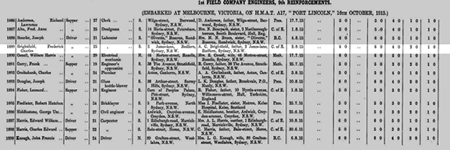
First World War Nominal Roll Page with Frederick Brightfield's details highlighted. Australian War Memorial.
Additional searches are needed for a veteran who was killed, missing or held as a prisoner of war to find further information.
Some record variations include:
-
an officer’s rank replaces the service number
-
an unfamiliar abbreviation was used
-
the final result was not recorded.
Note: If your veteran has a common surname you will get a large number of search results. Use the alphabetical listing of his Christian name, matched to his service number to find the exact record.
Where can I find details if the veteran was killed or reported missing in action?
Australian War Memorial Roll of Honour
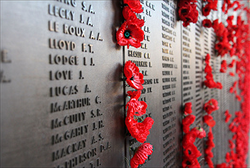
Honour wall at Australian War Memorial.
The Australian War Memorial Roll of Honour lists details for a veteran who has died as a result of battle. Usually the veteran’s date of death, serving unit, location, cause of death and sometimes a place of burial or commemoration are provided.
War Graves records
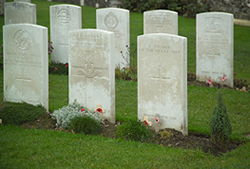
War cemetery near Passchendaele, Flanders.
The veteran’s service records or nominal roll entry show that they were killed. However, the place of burial is not recorded.
The Commonwealth War Graves Commission provides information on most, if not all, service personnel who died in the First World War. The search available under the Find War Dead tab provides a search which includes some of the veteran’s personal information
The federal Department of Veterans’ Affairs Office of Australian War Graves also provides an online search option.
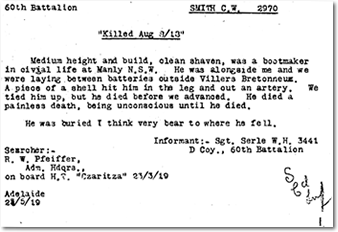 Eyewitness account of Private Charles William Smith’s death from Australian Red Cross Society Wounded and Missing Enquiry Bureau files, 1914-1918 War. Australian War Memorial. |
Red Cross records provide details about how a soldier was captured, wounded, killed and buried, from eye witness accounts. The names and service number of these eye witnesses are included. Some Red Cross records also include letters of enquiry and correspondence with family members. Search the First World War Red Cross Wounded and Missing records at the Australian War Memorial. These records can confirm actual locations and details as well as family and colleague connections. This information also assists in verifying information from other sources. |
|
60th Battalion SMITH C.W. 2970 “Killed Aug 8/13” Medium height and build, clean shaven, was a bootmaker in civil life at Manly N.S.W. He was alongside me and we were laying between batteries outside Villers Bretonneux. A piece of a shell hit him in the leg and out an artery. We tied him up, but he died before we advanced. He died a painless death, being unconscious until he died. He was buried I think very bear to where he fell. Informant:- Sgt. Serle W.H. 3441, d Coy. 60th Battalion Searcher:- R.W. Pfeiffer, Adm. Hdqrs., on board H.T. “Czaritza” 23/3/19 Adelaide 24/5/19 |
|
Case study examples using records from the Australian War Memorial, the Commonwealth War Graves Commission and the Australian Red Cross.
Search the Australian War Memorial WWI Red Cross files from the investigation into how he was killed and where he is buried. Access the Red Cross digitised record. Vincent Mahboub, from Lithgow, New South Wales, was about 30 when killed in action in France, 8 August 1918. He is buried in the Heath Cemetery, Harbonnieres, Amiens Harbonnieres Area, France. Further research finds that Vincent was born in northern Lebanon and migrated to Australia with his parents. He died fighting for Australia. |
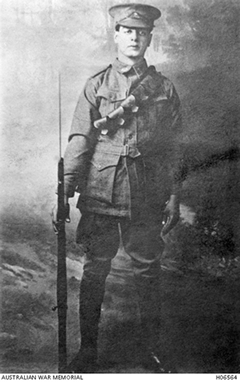 Vincent Mahboub. Public domain, Australian War Memorial. |
-
use Australian War Memorial Roll of Honour search
-
enter Charles William Smith
-
select the ‘Conflict, First World War, 1914 – 1918’.
There are several results for this name on the Roll of Honour. A service number, in this case 2970, will identify the correct veteran.
Charles Smith, like Vincent Mahboub, was also killed 8 August 1918 during the battle of Amiens, in France. Charles was aged 27 at the time; he was a member of the 60th Battalion (Infantry). He is remembered at the memorial at Villiers-Bretonneux, France, as his burial place is not marked.
A Red Cross digitised record contains details about how he died and where he is buried.
The Roll of Honour carries 757 names for the 60th Battalion.
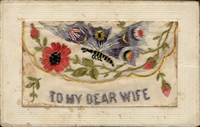
©Anzac Memorial, Hyde Park.
Charles sent a large number of hand-embroidered silk postcards (pictured) to his wife and infant son who were living in West Maitland during the war. The last postcard was posted the day before he was killed and concludes, ‘Looking forward to seeing you soon’.
The ANZAC Memorial in Hyde Park, Sydney, now holds these items as an important part of its collection.
|
The Commonwealth War Graves Commission provides information on most, if not all, service personnel who died from the First and Second World Wars. Use these records to find where Clarence James Brill is buried.
The results show that Clarence:
Selecting Clarence’s name provides additional information, including a link to the cemetery, where more details and images are available. A commemorative certificate (pictured) can be printed to acknowledge Clarence Brill. |
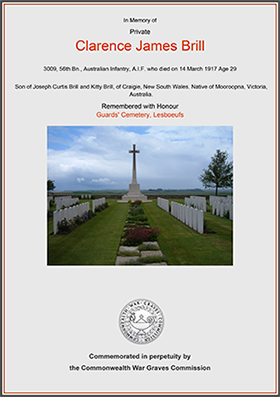 ©Commonwealth War Graves Commission |
Killed or missing
How do you know if your veteran has been killed, missing or held as a prisoner of war?
The summary of details provided on the Nominal Roll for each veteran includes a code in the second last column that indicates, for example, if they returned to Australia (R.T.A.), were killed in action (K.I.A.) or died of wounds (D.O.W.) and the date. If the code is other than R.T.A then this alerts you to the need to look at additional archives. Reference the Australian War Memorial Glossary to assist with these codes.
You can also search the Australian War Memorial Roll of Honour, which includes the names of all Australians killed in action.
The Commonwealth War Graves Commission provides a search function to locate the cemeteries, burial plots and memorials of the Australian war dead. A detailed search function ‘Find War Dead’ allows you to verify the research information you have found with the information compiled by the Commission.
Red Cross
Where can I find out about those who were killed, missing or held as a prisoner of war?
If your veteran did not return to Australia you will need to search at Australian War Memorial Red Cross Wounded and Missing.
These records may contain information not included in the veteran’s service records or vice a versa. In combination these records can provide a detailed picture of what happened, particularly if the veteran was killed or captured. If they were held as a prisoner of war, you could research the camp or location they were held in, who else was a prisoner with them, what the conditions were like and how long they were interned for. Experiences as a prisoner of war varied greatly.
The Red Cross Records for those killed can be quite detailed with some information provided by eye witnesses. These records may also identify where they are buried. However some soldiers do not have an identified grave.
The International Committee of the Red Cross (ICRC) has digitised its archives at Prisoners of the First World War. Reference the archived records and information about internment camps.
